Research Article :
Plekhanov VG Artificial activation of the strong interaction by
adding of one neutron to the nucleus causes the global reconstruction of the
macroscopic characteristics of solids. The experimental evidence of macroscopic
manifestation of the strong interaction in optical spectra of solids which are
different by term of one neutron from each other (using LiD crystals instead of
LiH) has been presented. This evidence is directly seen from luminescence
(reflection) and scattering spectra. As far as the gravitation, electromagnetic
and weak interactions are the same in both of kind crystals, it only emerges
the strong interaction in deuterium nucleus. Therefore a sole conclusion is
made that the renormalization of the energy of electromagnetic excitations
(electrons, excitons, phonons) is carried out by the strong nuclear
interaction. There is a common place in Standard Model of modern physics that
the strong nuclear force does not act on leptons. Our experimental results show
the violation of this strong conclusion. The necessity to take into account the
more close relation between quantum chromodynamics and quantum electrodynamics
is underlined. In the first step the quantum electrodynamics should be taken
into account the strong interaction at the description of elementary excitations
(electrons, excitons, phonons) dynamics in solids. Our experimental results may
shed light on a number of fundamental puzzles in modern physics, particularly
on the unification of forces.
The
subject of elementary particle physics to have begun with the discovery of the electron
more than century ago. In the following 50 years, one new particle after
another was discovered, mostly as a result of experiments with cosmic rays, the
only source of very high energy particle then available. After second war the
accelerator technique was used to study the elementary particle physics.
Nuclear and particle physics are essentially at the forefront of nowadays
understanding of physics. Nucleus is a bound system of strongly interacting
protons and neutrons. Unfortunately, modern QCD does not provide us with the
tools to calculate the bound states properties of the proton (deuteron) from
first principles [1]. In
this connection the new experimental data about strong nuclear interaction are
very valuable. The present paper is devoted to the results of measurements of
residual strong nuclear interaction via the study the low-temperature optical
spectra (reflection, photoluminescence) of the LiH (without strong interaction
in hydrogen nucleus) and LiD (with strong interaction in deuterium nucleus)
crystals which differ by term of one neutron from each other. We should repeat
that nowadays in textbooks and elsewhere the separation of electromagnetic and
strong interaction is tacitly assumed. It is very strange because up to present
time we do not even know the strong nuclear force very well. The origin of the
strong interaction is very important especially in the problem of all force
unification [2-4]. The
results of the paper have shown a new light on some residual strong nuclear
interaction (ultimately based in the character of magnetic forces, the
electromagnetic or color origin, which by their very nature, are difficult to
conceal within the elusive nucleon physical boundary) between both kind of
forces which experimentally manifested through isotopic shift of zero phonon
line in optical spectra [5]. As
indicated above, there is a common place in SM of modern physics that the
strong force does not act on leptons [6] (Figure
1). Figure
1: Summary of interactions
between particles described by the Standard Model. Following
this conclusion, we do not must to observe the dependence of the optical
properties of solids on addition neutrons in substance. This contradicts the
history of the development of isotope effect. The first attempt to discover an
interaction between neutrons and electrons was made by Dee in the same year,
1932 in which the neutron was discovered by Chadwick [7,8]. Discovery of the
neutron by Chadwick in 1932 may be viewed as the birth of the strong
interaction: it indicated that nucleus consists of protons and neutrons and hence
the presence of force that holds them together, strong enough to counteract the
electromagnetic repulsion. In 1936, Condon pointed out that the existence of a
neutron - electron interaction would give rise to an isotope shift in spectral
lines of atoms, which was observed for the first time by Aronberg in 1918 in
the line spectra of Pb isotopes [9-11]. The existence of a weak attractive
interaction between electrons and neutrons has been described in the series
papers by Foldy [12]. Foldy
has showed that neutron-electron interaction has two contributions - one
arising from anomalous magnetic moment of the neutron and the other from an
intrinsic Darwin coefficient-electric field. This picture was justifiable in
meson theory though both of these contributions have a common origin [5,12,14].
In all methods of the measurements there are principal troubles connected with
the necessity of introducing large corrections in size of order of the
investigated effect of neutron - electron interaction [14]. Besides
there is intrigue in the fact that all known experimental values were scattered
around the so called Foldy scattering length in the interval 10%. The main
conclusion of the fundamental papers by Foldy is that the intrinsic neutron-electron
interaction is essentially an electromagnetic interaction between the neutron
and the charge density producing an external electromagnetic field by electron
[12,14-16]. According
to contemporary physics the strong force does not act on lepton (electrons, positrons,
muons and neutrinos), but only on protons and neutrons (more 3 generally, on
baryons and mesons - this is the reason for the collective name hadrons). The
strong interaction (also known as hadronic interaction) holds atomic nuclei
together and, in another context, binds quarks within hadrons The baryons are bound
states of three quarks, and mesons are composed of quark and antiquark [1,17]. It
should be added that the forces between the quarks must be long range, because
the gluons (as photons) have zero mass. This does not imply that the forces
between hadrons are also long range, because hadrons have zero color charges
overall. The forces between the colorless hadrons are the residues of the for
as between their quark constituents, and cancel when the hadrons are far apart
[1,16]. In 1935, Yukawa pointed out that the nuclear force could be generated
by the exchange of a hypothetical spin less particle, provided its mass
intermediate between the masses of proton and electron - a meson. Yukawa predicted
the pion [1,17,18]. The macroscopic manifestations of the strong interaction are
restricted up to now to radioactivity and the release of nuclear energy. The
Table 1 given for the strength and
range of the forces come from a comparison of the effects they produce on two
protons [19]. In some respect these resemble an ordinary Newtonian force
between the protons, varying with the distance between them as if the force was
derived from a potential function: for some n. This is an inverse - power force
which is diminished by an exponential factor at distances larger than a certain
distance R, the range of the force. The strength of the force is measured by
the constant k. The unit of strength is hc/2π where h is Planck’s constant and
c the speed of light. Thus nuclear physics was essentially the paradigmatic example
of understanding particle physics. The modern quantum mechanical view of the three
fundamental forces (all except gravity) is that particles of matter (fermions
neutrons, protons, electrons) do not directly interact with each other, but
rather carry a charge, and exchange virtual particles (gauge bosons photons,
gluons, gravitons) which are the interaction carriers or force mediators. As it
can be seen from Table 1 [19], photons are the mediators of the interaction of
electric charges (protons, electrons, positrons); and gluons are the mediators
of the interaction of color charges (quarks). In our days, the accepted view is
that all matter is made of quarks and leptons (Figure 1). As it can be seen, of the three pairs of quarks and
leptons, one pair of each - the quark u and d and the leptons e and υe (electrons
neutrino) - are necessary to make up the everyday world, and a world which
contained only these would seem to be quite possible. Table 1: The four
fundamental forces. Here FQ-Field
Quant, RS-Relative Strength, TC-S-Typical Cross- Section, TTS-Typical time
scale. As we can see above
the method of the scattering particles allows to determine only length of
scattering as well as the size and depth (highest) of the neutron’s potential.
In the present paper we attempt to measure the energy of the neutron-electron
interaction via spectroscopic study of the optical characteristics of solids
with isotope effect at low temperature. Therefore, it is purpose of our paper
to advance a description of the manifestation of strong nuclear interaction in
solids, using partly published and new non-accelerator experimental results.
Our spectroscopic measurement of the low temperature optical characteristics of
LiHxD1-x crystals is permitted to
quantitative study of the dependence of strong coupling constant, αs,
on the proton - neutron distance in the deuteron nuclei. Another purpose of our
communications is to draw the attention of physical society towards the
expansion of the QED boundary via taking into account new experimental non -
accelerates manifestation of the residual strong interaction in solids. Below
we will briefly describe the results of the optical spectroscopy of isotope -
mixed crystals. We should underline that these crystals are different by term
of one neutron from each other (using LiD crystals instead of LiH ones). In
this paper we shall present all the details of our experimental results which
we omitted in the previous paper and in a series of international conference. The apparatus used
in our experiments has been described in several previous publications [20-23].
For clarity, we should mention here that immersion home-made helium cryostat
and two identical double - prism monochromators were used. One monochromator
was used for the excitation and the other, which was placed at right – angle to
the first for analyzing the luminescence and scattering of light. In our
experiments we investigated two kinds of crystals (LiH and LiD) which are
differing by a term of one neutron. Lithium hydride and
lithium deuteride are ionic insulating crystals with simple electronic structure,
four electrons per unit cell, both fairly well – described structurally (neutron
diffraction) and dynamically (second – order Raman spectroscopy) and through ab
initio electronic structure simulation. Among other arguments, LiH and LiD are
very interesting systems due to their extremely simple electronic and energy
structure and to the large isotopic effects when the hydrogen ions are replaced
by the deuterium ones. On the other hand, the light mass of the ions, specially
H and D, makes that these solids have to be considered like quantum crystals,
and consequently, described theoretically by quantum theory. In a solid one
deals with a large number of interacting particles, and consequently the
problem of calculating the electronic wave functions and energy levels is
extremely complicated. It is necessary to introduce a number of simplifying
assumptions. In the first place we shall assume that nuclei in the crystalline
solid are at rest. In an actual crystal this is of course never the case, but
the influence of nuclear motion on the behavior of electrons may be treated as
a perturbation for the case in which they are assumed to be at rest. Even with
above assumption, however, we are still with a many – electron problem which
can be solved only be approximative methods. In the case of solids, the most
important approximative method which has been applied extensively is the so –
called one – electron approximation. In this
approximation the total wave function for the system is given by a combination
of wave functions, each of which involves the coordinates of only one electron.
In other words, the field seen by a given electron is assumed to be that of the
fixed nuclei plus some average field produced by the charge distribution of all
other electrons [23]. The difference between a good conductor and a good
insulator is striking. The electrical resistivity of a pure metal may be as low
as 10-10 ohm-cm at a temperature of 1 K, apart from the possibility
of superconductivity. The resistivity of good insulator may as high as 10-22
ohm-cm. They understand the difference between insulators and conductors, we
shall use the band–gap picture (Figure
2). The possibility of band gap is the most important property of solids. The
single crystals of LiH and LiD were grown from the melt by the modified method
of Bridgeman-Stockbarger [20,21]. The crystals were synthesized from 7Li
metal and hydrogen of 99.7% purity and deuterium of 99.5% purity. Figure
2: Various possibilities to
present the band - structure of homogeneous undoped insulator (semiconductor).
1 - the dipersion relation, i.e. the energy E as afunction of the wave vector Virgin crystals had
a slightly blue - grey color, which can be attributed to nonstoichiometric excess
of lithium present during the grown cycle. On annealing for several days (up to
20) at 500℃ under ~3 atm of hydrogen or deuterium, this color could be almost
completely eliminated. Because of the high reactivity and high hygroscopy of
investigated crystals should be protected against the
surrounging atnosphere was necessing. Taking into account this circumstance, we
have developed special equipment which is allowed to prepare samples with a
clean surface cleaving their in the bath of helium cryostat with normal
or superfluid liquid helium [20]. The samples with such surface allow to
perform measurements during 15 hours. An
improved of LiH (LiD) as well as mixed crystals were used in the present study.
In spite of the identical structure of all free – exciton luminescence spectra,
it is necessary to note a rather big variation of the luminescence intensity of
the crystals from the different batches observed in experiment (Figure 2). We should remind
very briefly about the electronic excitations in solids. According to modern
concept, the excitons can be considered [23] as the excited of the N –
particles system: An electron from the valence band is excited into the
conduction band (Figure 2). The
attractive Coulomb potential between the missing electron in the valence band,
which can be regarded as a positively charged hole, and the electron in the
conduction band gives a hydrogen - like spectrum with an infinitive number of
bound state and ionization continuum (Figure
3). Below we will
briefly describe the results of the optical spectroscopy of isotope - mixed
solids. In our experiments we have investigated the low – temperature optical
spectra (reflection, luminescence and scattering of light) of LiHxD1-x
crystals (0≤x≤1) which are differ by term of one neutron from each other (Figure 3). Figure 3: Discrete and continous (hatched area) Wannier - Mott exciton energy spectrum
taking into account its kinetic energy h2k2/2M. The
broken line connects to the dispersion of light in the medium. R - is the
exciton binding energy, n=1, 2, 3, .... The
usual way to determine the optical properties of a solid is to shine
monochromatic light onto an appropriate sample and then to measure the reflectance
or transmittance of the sample as a function of photon energy. In the spectral
region of greatest interest is generally quite high, so that often a negligible
small fraction of the incident light is transmitted.
It is the main reason, that the most experiments are measurements of the reflectivity.
The mirror reflection spectra of mixed and pure LiH and LiD crystals, cleaved
in superfluid helium are presented on Figure
4. All spectra have been measured with the same apparatus
under the same conditions. As can clearly see in Figure 4 all spectra exhibit a
similar long – wave structure. As the deuterium concentration increases, the
long – wave maximum (n _ 1S excitons [23]) broadens and shifts towards the
shorter wavelengths. The energy values of exciton maxima for pure and mixed
crystals at 2 K are presented in Table 4 of reference [25]. As demonstrated
early most low - energy electron excitation in LiH crystals are the large -
radius excitons [22,23] (Figure 4). Figure
4: Mirror reflection spectra
of indicated crystals at 2 K. Light source without crystals indicates by lamp. Photoluminescence
is the optical radiation emitted by a physical system (in excess of the thermal
equilibrium blackbody radiation) resulting from excitation to a nonequilibrium state
by irradiation with light. Photoluminescence is also rapidly evolving into
major basic research tool comparable to absorption (reflection) measurements in
importance. Two reasons for this stand out as significant. First is the sensitivity
of the luminescence technique. It often happens that features which are just
discernible in absorption will completely dominate the luminescence spectra.
The converse is also sometimes true, making luminescence and
absorption (reflection) complementary techniques. Second is the simplicity of
data collection. In last half- century the luminescence method has become one of
the most common techniques for studying excitons in dielectrics and
semiconductors. While the structure
of spectra of fundamental reflection (absorption) depends on the internal degrees
of freedom of Wannier – Mott exciton, the structure and shape of the
luminescence spectrum are determined primarily by its external degrees of
freedom. The latter are associated with the translation motion of large –
radius exciton as a whole, with the translation mass M=me + mh
, where me and mh – effective masses of
electron and hole, respectively. Free exciton
luminescence is observed when LiH (LiD) crystals are excited in the midst of
the fundamental absorption. The spectrum of free exciton photoluminescence of
LiH crystals cleaved in superfluid helium consists of a narrow (in the best
crystals, its half - width is ΔE≤ 10 meV) phononless emission line and its
broader phonon repetitions, which arise due to radiated annihilation of
excitons with the production of one to five LO phonons (Figure 5). Figure
5: Photoluminescence
spectra of free excitons at 2 K in LiH and LiD crystals cleaved in superfluid
helium. The phononless
emission line coincides in an almost resonant way with the reflection line of
the exciton ground state which is indication of the direct electron transition
X₁ - X₄ of the first Brillouin zone [26]. The lines of phonon
replicas form an equidistant series biased toward lower energies from the
resonance emission line of excitons. The energy difference between these lines
in LiH crystals is about 140 meV, which is very close to the calculated energy
of the LO phonon in the middle of the Brillouin zone and which was measured in (see,
e.g. [22] and references quoted therein) [26]. The isotopic shift
of the zero – phonon emission line of LiH crystals equals 103 meV. As we can
see from Figure 5 the photoluminescence
spectrum of LiD crystals is largely similar to the spectrum of intrinsic luminescence
of LiH crystals. There are, however, some distinctions one is related. Firstly the
zero - phonon emission line of free excitons in LiD crystals shifts to the
short-wavelength side on 103 meV. These results directly show the violation of
the strong conclusion that the strong force does not act on leptons [1,17]. The
second difference concludes in less value of the LO phonon energy, which is
equal to 104 meV. The simplest approximation, in which crystals of mixed
isotopic composition are treated as crystals of identical atoms having the
average isotopic mass, is referred to as VCA [23]. When light is
excited by photons in a region of fundamental absorption in mixed LiHxD1-x
crystals at low temperature, line luminescence is observed (Figure 6), like in the pure LiH and
LiD crystals. As before [25], the luminescence spectrum of crystals cleaved in superfluid
liquid helium consists of the relatively zero - phonon line and its wide LO
replicas. or the sake of convenience, and without scarfing generality, Figure 6 shows the lines of two replicas.
Usually up to five LO repetitions are observed in the luminescence spectrum as described
in detail in [20]. In Figure 6 we see immediately that the structure of all
three spectra is the same. The difference is in the distance between the
observed lines, as well as in the energy at which the luminescence spectrum
begins, and in the half - width of the lines. Figure
6: Photoluminiscence spectra of free excitons in LiH
(1), LiHxD1-x (2) and LiD (3) crystals cleaved in superfluid helium at 2 K.
Spectrometer resolution is shown. At the excitation
below the intrinsic absorption edge (En=1s=5.043 eV for LiD
[22]) we have succeeded in observing the multiphonon RRS with the creation of
up four phonons (Figure 7). Indeed,
the energy difference between peaks in the RRS spectrum is equal the energy of
the LO phonons in the center of the Brillouin zone [23,28]. Figure
7: Resonant Raman
scattering of a LiD crystals at the excitation E _ 4.992 eV at 4.2 K. To pay attention
the large half - width of observable lines in the RRS spectrum. As was shown in
the paper their half - width are always larger than of the excitation line. The
proximity of the exciting light frequency to the energy of exciton transitions
leads to an essential modification of the selection rules for light scattering.
The presence of the second - order Figure 8: Dependence of the interband transition (strong interaction strength) energy Eg in mixed crystals on the concentration x (number of neutrons N). The straight dashed line is the linear
dependence of coupling constant strong interaction αs=f(N) [Eg= f(x) in the virtual model.
The solid line corresponds to
calculation using the polynom of second degree αs= αs=(LiD)+ [αs(LiH- αs(LiD)- b]x-bx2
, where, b=0. 046 eV is curvature parameter [23]. Points derived from
the reflection spectra indicated by crosses and those from luminescence spectra by triangles. Figure 8 shows the concentration dependence of the energy of interband transition Eg (Figure 2). As can be seen from Figure 8, VCA method (the straight dashed line) cannot describe observed experimental results. This dependence has a nonlinear character. Comparison the
experimental results on the luminescence (reflection) and light scattering in
the crystals which differ by a term of one neutron only is allowed to the next conclusions; 1. At the adding
one neutron (using LiD crystals instead LiH ones) is involved the increase
exciton energy on 103 meV. 2. At the addition
one neutron the energy of LO phonons is decreased on the 36 meV, that is direct
seen from luminescence and scattering spectra. Both
characteristics are macroscopic. Traditionally
nuclear - electron interaction (in our case neutron - electron interaction) taking
into account the solving of Schrödinger equation using Born – Oppenheimer (adiabatic)
approximation [29]. Since electrons are much faster and lighter than the nuclei
by a factor nearly 2000 the electron charge can quickly rearrange itself in
response to the slower motion of the nuclei, and this is the essence of the
Born – Oppenheimer approximation. This approximation results the omission of
certain small terms which result from the transformation. As was shown in [30]
the eigenvalue (energy) of the electronic Schrödinger equation (equation 6 in
[28]) depends on the nuclear charges through the Coulomb potential, but it
doesn’t include any references to nuclear mass and it is the same for the
different isotopes. The independent of the potential energy (the eigenvalue of
the Schrödinger equation) is the essence adiabatic approximation. However, we
must repeat, that the Born - Oppenheimer approximation is the standard anzatz
to the description of the interaction between electrons and nuclei in solids [31].
The last result is
forcing us to search for new models and mechanisms of nuclear - electron
interaction including results of subatomic physics, e.g. hadron - lepton
interaction. Out of four known interactions, three are described by SM - the
electromagnetic, weak and strong ones. The first two of them have a common
electroweak gauge interaction behind them. The symmetry of this interaction
SU(2)L X U(1)Y manifests itself at energies higher than ~200
GeV. At lower energies, this symmetry is broken down to U(1)EM≠U(1)Y
(the electroweak symmetry breaking): in SM this breaking is related to
the vacuum expectation value of a scalar field [17]. The strong interaction in
SM is described by the QCD, a theory with the gauge group SU(3)C.
The effective coupling constant of this theory grows when the energy decreased.
As a result, particles which feel this interaction cannot exist as free states
and appear only in the form of bound states called hadrons [1]. Most of modern
methods of quantum field theory work at small values of coupling constant, αs,
[32], that is, for QCD, at high energies. Quarks and leptons, the so - called
SM matter fields, are described by fermionic fields. Quarks take part in strong
interactions and compose observable bound state hadrons. Both quarks and
leptons participate in the electroweak interaction. The matter fields
constitute three generation: particles from different generation interact
identically but have different masses [17]. For the case of neutrino, Yukawa
interactions are forbidden as well, so neutrinos are strictly massless in SM
(see, however [30] and references therein)). The gauge bosons,
which are carriers of interactions, are massless for unbroken gauge groups U(1)EM
(electromagnetism 13 - photons) and SU(3)C (QCD - gluons), masses of
W± and Z0 bosons are determined by the mechanism of
electroweak symmetry breaking. It should be noted that the forces between the quarks
must be long rang, because the gluons have zero mass. This does not imply that forces
between hadrons are also long range, because hadrons have zero color charges overall.
The forces between the colorless hadrons are the residues of the forces between
their quark constituents, and cancel when the hadrons are far apart. Returning to our
non - accelerator experimental results, we should underline that in this paper
we measure the strong nuclear interaction in crystals which differ by term of
one neutron from each other. When we add one neutron in the hydrogen nucleus,
we artificial activated of the strong interaction. As far as the gravitation,
electromagnetic and weak interactions are the same in both kind crystals (LiH
and LID), it only changes the strong interaction. Therefore a logical
conclusion is made that the renormalization of the energy of electromagnetic
excitations (isotopic shift equals 0.103 eV) is carried out by strong nuclear interaction.
The short range
character of the strong interaction of nucleons does not possess direct
mechanism of the elementary excitation (electrons, excitons, phonons) energy
renormalization, which was observed in our low temperature experiments. Second reason
that the interpretation of our experimental results is very difficult task
because they are first demonstration of the violation of the strong conclusion
in nuclear and particles physics that the strong nuclear force does not act on
the colorless leptons [1,32]. Moreover we have some contradictions taking into
account that the forces between quarks must be long range, because the gluons
have zero mass. But as was mentioned above, the short range when forces between
the colorless hadrons are the residues of the forces between their quark
constituents, and cancel when the distance between hadrons is more than nuclear
size [17]. We can see that the
nuclear size transforms long range interaction in the short range strong one.
It is very old question which up to present time has not any theoretical
explanation. In spite of above discussion, at present time we can distinguish
the following mechanisms of the isotopic shift zero phonon line: 1. Long range
electric field of the neutron’s quarks. This mechanism owing to the confinement
quarks is limited by the boundary of the neutron. 2. The possible new
structure of the quarks and leptons - so - called preons [33]. 3. The most likely
mechanism of the neutron - lepton interaction is connected to the magnetic -
like strong field of neutron’s quarks. Taking into account anomalous magnetic
moment of the neuron [14,34] in the paper [5] was obtained the value of strong
coupling constant αs=2.4680.
Quite large value in comparison with the accelerator technique value _αs(MZ)=0.1198
[32]. The large value αs is thus justified to think that residual
strong forces acting beyond nucleon could exist. A possible interpretation is
to assume that in addition to the 8 gluons predicted by QCD SU(3)c
group there is a ninth gluon color singlet [17]. This massless
photon - like gluon may be strongly interacts between nucleons (neutrons) and
leptons (electrons) [1,17]. Returning to Figure
8 we can note that our measurements permit value to obtainment of strong
coupling constant from _ αs=2.4680 (pure LiD crystals) to αs=0
(pure LiH crystals). Moreover, in Figure 9 we show the dependence of αs
on neutron’s number in different substances. We can see as early in the case of
pure LiD crystals we have non - linear dependence of αs on the neutron’s
number in different substances, which as in the case LiHxD1-x
doesn’t have any theoretical explanation (Figure 9). Figure
9: The dependence of the
strong force on the number of neutrons in different substances. Thus,
the tentative interpretation of describing non-accelerator experimental results
does not find consistent explanation at the change of strong interaction
leaving to another mystery of SM [6]. We should remind that intrinsic
contradiction of Standard Model is already well - known. Really, the Lagrangian
of quantum chromodynamics (theory of the strong interaction) has the next form
[19]: The artificial
activation of the strong nuclear interaction by adding one (two or more) neutrons
in atomic nuclei leads it to the direct observation of the strong interaction
in low - temperature optical spectra of solids. This conclusion opens new
avenue in the investigation of the constant of strong nuclear interaction in
the wide value range by means the condensed matter alike traditional methods.
Our experimental non-accelerator results may shed light on a number of
fundamental puzzles in modern physics, particularly on the unification of
forces. Experimental observation of the renormalization of the elementary excitation
energy of solids by the strong nuclear interaction stimulates its count in the process
of description of the elementary excitations dynamics in quantum
electrodynamics. Besides, we should highlight that such important information
has been obtained via rather simple and inexpensive experimental physics
equipment. Present article continuous to develop between nuclear, high energy
and condensed matter physics. References
Plekhanov VG, Fonoriton Scientific Laboratory, Garon Ltd., Tallinn, 11413, Estonia, E-mail: vgplekhanov@gmail.com Plekhanov VG. Isotope effect is the paradigm of a non-accelerator study of the residual nuclear strong interaction (2020) Edelweiss Chem Sci J 3: 8-14 Strong interaction, Quarks, Gluons, Excitons,
Phonons, Quantum chromodynamics and ElectrodynamicsIsotope Effect is the Paradigm of A Non-accelerator Study of the Residual Nuclear Strong Interaction
Abstract
Full-Text
Introduction
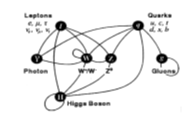


Experimental
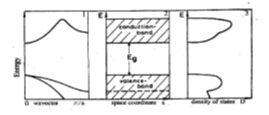
![]() , 2 - the energy
regions of allowed and forbidden statesas function of a space coordinate x and
3 - the density of states (all curves are schematic ones) [23].
, 2 - the energy
regions of allowed and forbidden statesas function of a space coordinate x and
3 - the density of states (all curves are schematic ones) [23].
Results
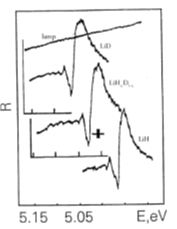
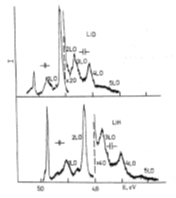
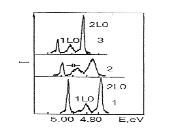
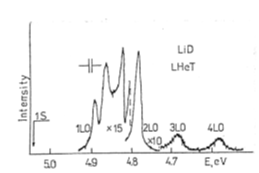
 meV for LiH) in the RRS spectrum may be explained by a relatively strong
scattering deformation mechanism in these crystals, where, however the main
mechanism, as was seen from both figures, is Frőchlich mechanism of intraband scattering
[23]. The long wavelength displacement of the excitation line frequency
relatively exciton resonance a monotonic decrease the intensity of RRS spectrum
as whole more than 60 - fold in both LiH and LiD crystals [22].
meV for LiH) in the RRS spectrum may be explained by a relatively strong
scattering deformation mechanism in these crystals, where, however the main
mechanism, as was seen from both figures, is Frőchlich mechanism of intraband scattering
[23]. The long wavelength displacement of the excitation line frequency
relatively exciton resonance a monotonic decrease the intensity of RRS spectrum
as whole more than 60 - fold in both LiH and LiD crystals [22].
Discussion


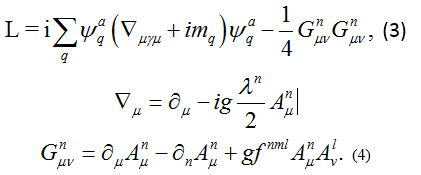
 quark
and gluon fields, a_1,2,3,...8 are color indices λn, and fnml
are Gell- Mann matrices and f symbols, mq - are bare (current)
masses, q=u, d, s, c, ... different quarks. It is common place [1,32] that the
Lagrangian (3) contains the members which describe both free motion and
interaction between quarks and gluons, which is defined by the strength couple
g. Spacing of which it is necessary to remark that although the Lagrangian (3)
possesses rather attractive peculiarities [19,30,33], its eigenstates are the
quarks and the gluons which are not observed in free states [17,35-37]. The
observed hadrons in the experiment don’t eigenstates in quantum chromodynamics.
It is obvious to expect that the modern theory of QCD should finally overcome
these difficulties, for example inserting QCD in QED.
quark
and gluon fields, a_1,2,3,...8 are color indices λn, and fnml
are Gell- Mann matrices and f symbols, mq - are bare (current)
masses, q=u, d, s, c, ... different quarks. It is common place [1,32] that the
Lagrangian (3) contains the members which describe both free motion and
interaction between quarks and gluons, which is defined by the strength couple
g. Spacing of which it is necessary to remark that although the Lagrangian (3)
possesses rather attractive peculiarities [19,30,33], its eigenstates are the
quarks and the gluons which are not observed in free states [17,35-37]. The
observed hadrons in the experiment don’t eigenstates in quantum chromodynamics.
It is obvious to expect that the modern theory of QCD should finally overcome
these difficulties, for example inserting QCD in QED.Conclusion
*Corresponding author:
Citation:
Keywords